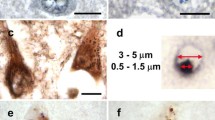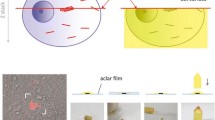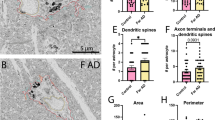Abstract
This study investigated terminal dUTP nick-end labeling (TUNEL)-positive cells in the frontal, occipital, and hippocampal cortices of seven normal aging and four Alzheimer’s patients. Significant increase in TUNEL-positive cells was observed in the frontal and hippocampal cortices of Alzheimer’s patients when compared with controls. In the hippocampal cortex, only area CA4 demonstrated a significant increase of TUNEL-positive cells. Double staining of TUNEL-positive cells for glial fibrillary acidic protein revealed that <13% of the TUNEL-positive nuclei belonged to astrocytes. The results of this study illustrated a differential pattern of cortical degeneration between normal aging and Alzheimer patients.
Similar content being viewed by others
References
Anderson A. J., Su J. H., and Cotman C. W. (1996) DNA damage and apoptosis in Alzheimer’s disease: colocalization with c-jun immunoreactivity, relationship to brain area, and effect of postmortem delay.J. Neurosci. 16, 1710–1719.
Charriaut-Marlangue C. and Ben-Ari Y. (1996) A cautionary note on the use of the TUNEL stain to determine apoptosis.Neuroreport 7, 61–64.
Cohen J. J. (1993) Apoptosis.Immunol. Today 14, 126–130.
Conn H. J., Darrow M. A., and Emmel V. M. (1960)Staining Procedures, 2nd ed. Williams & Wilkins, Baltimore, MD.
Dragunow M., Faull R. L. M., Lawlor P., Beilharz E. J., Singleton K., Walker E. B., and Mee E. (1995) In situ evidence for DNA fragmentation in Huntington’s disease striatum and Alzheimer’s disease temporal lobes.Neuroreport 6, 1053–1057.
Flicker C. and Ferris S. H. (1987) Cognitive processes: dementia, inEncyclopaedia of Aging (Maddox G. L., ed.), Springer, New York, pp. 124,125.
Lassmann H., Bancher C., Breitschopf H., Wiegel J., Bobinski M., Jellinger K., and Wisniewski H. M. (1995) Cell death in Alzheimer’s disease evaluated by DNA fragmentation in situ.Acta Neuropathol. 89, 35–41.
Lockshin R. A. and Zakeri Z. F. (1990) Programmed cell death: new thoughts and relevance to aging.J. Gerontol. 45, 135–140.
Lucassen P. J., Chung W. C. J., Vermeulen J. P., Van Lookeren Campagne M., Van Dierendonck J. H., and Swaab D. F. (1995) Microwave-enhanced in situ end-labeling of fragmented DNA: parametric studies in relation to postmortem delay and fixation of rat and human brain.J. Histochem. Cytochem. 43, 1163–1171.
Raff M. C. (1992) Social controls on cell survival and cell death.Nature 356, 397–400.
Scheff S. W. and Price D. A. (1993) Synapse loss in the temporal lobe in Alzheimer’s disease.Ann. Neurol. 33, 190–199.
Shu S. Y., Ju G., and Fan L. Z. (1988) The glucose oxidase-DAB-nickel method in peroxidase histochemistry of the nervous system.Neurosci. Lett. 85, 169–171.
Smale G., Nichols N. R., Brady D. R., Finch C. E., and Horton W. E. Jr. (1995) Evidence for apoptotic cell death in Alzheimer’s disease.Exp. Neurol. 133, 225–230.
Steller H. (1995) Mechanisms and genes of cellular suicide.Science 267, 1445–1449.
Su J. H., Anderson A. J., Cummings B. J., and Cotman C. W. (1994) Immunohistochemical evidence for apoptosis in Alzheimer’s disease.Neuroreport 5, 2529–2533.
Terry R. D., Masliah E., Salmon D. P., Butters N., DeTeresa R., Hill R., Hansen L. A., and Katzman R. (1991) Physical basis of cognitive alterations in Alzheimer’s disease: synapse loss is the major correlate of cognitive impairment.Ann. Neurol. 30, 572–580.
Thomas L. B., Gates D. J., Richfield E. K., O’Brien T. F., Schweitzer J. B., and Steindler D. A. (1995) DNA end labeling (TUNEL) in Huntington’s disease and other neuropathological conditions.Exp. Neurol. 133, 265–272.
Thompson C. B. (1995) Apoptosis in the pathogenesis and treatment of disease.Science 267, 1456–1462.
Author information
Authors and Affiliations
Rights and permissions
About this article
Cite this article
Li, W.P., Chan, W.Y., Lai, H.W.L. et al. Terminal dUTP nick end labeling (TUNEL) positive cells in the different regions of the brain in normal aging and alzheimer patients. J Mol Neurosci 8, 75–82 (1997). https://doi.org/10.1007/BF02736774
Received:
Accepted:
Issue Date:
DOI: https://doi.org/10.1007/BF02736774




